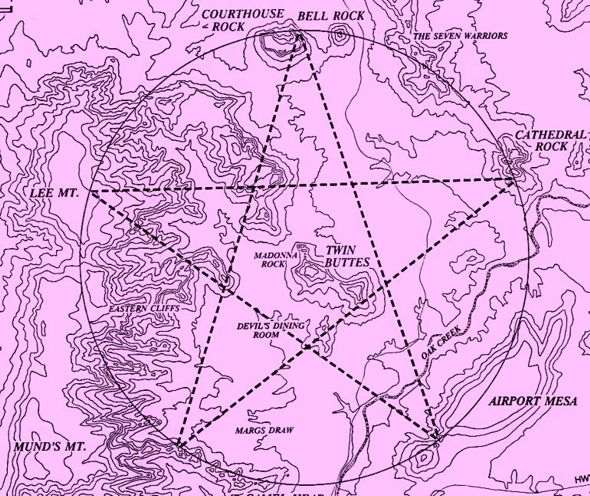Since the first version of this article in 2001, based on Nicholas Mann’s book Sedona Sacred Earth, providence has led me on many journeys and experiences in the beautiful sites of this garden called Earth. And yet Sedona keeps calling me back to marvel in awe at nature’s crafting and molding the cathedrals and monolithic beings in red stone.
Nicholas Mann was my husband during the time of his writing Sedona Sacred Earth (late 1980s), and we explored together the landscape temple of Sedona. Using his maps, dowsing and geometric calculations and my intuition and knowledge of the region, we wove through the sites, listening, sometimes literally hearing together an ancient song rising from deep within the Earth.
It was during our visits during the 1980s to see White Bear Fredericks, a Hopi elder and chief of the Bear Clan that the research began to make sense. (See Book of the Hopi by Frank Waters and The History of the Hopi by White Bear and Kaih King) When Nicholas mentioned to White Bear his discovery of not only a five-pointed star in the Sedona landscape, but also a perfect six-pointed star, an important missing piece to the puzzle emerged. White Bear was deeply moved by Nicholas’ discovery of the hexagram pattern in Sedona. He told us that these same six points were very sacred to the Hopi Snake Clan and that ceremonies would have been held at some of these six sites.
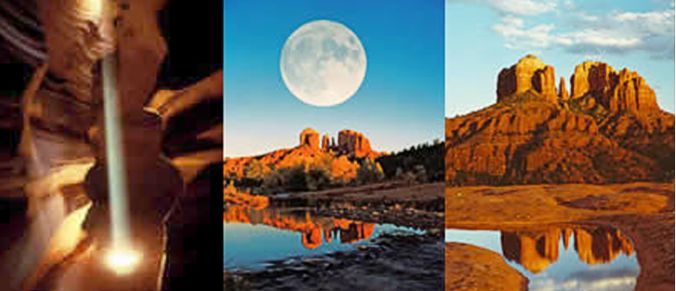
Since that time, I have met with various researchers and authors of sacred geometry and it appears star patterns are not unique to Sedona. In Scotland, I met and befriended Gordon Strachan, who was a professor at Edinburgh University and a minister of the Church of Scotland for thirty years. Gordon wrote numerous wonderful books, including Chartres—Sacred Geometry, Sacred Space, in which he demonstrates the hexagram and pentagram in the Chartres Cathedral design.
At Roslin, Scotland, I met researcher David Bews, who discovered a perfect pentagram formed by old churches and castles in Caithness, Scotland. In Rennes-le-Chateau, France I was introduced to Henry Lincoln, who is most famous as one of the authors of Holy Blood—Holy Grail. Henry had discovered a mathematically perfect pentagram and hexagram in the South of France, marked by Knight Templar commanderies, medieval churches and prominent landscape features.
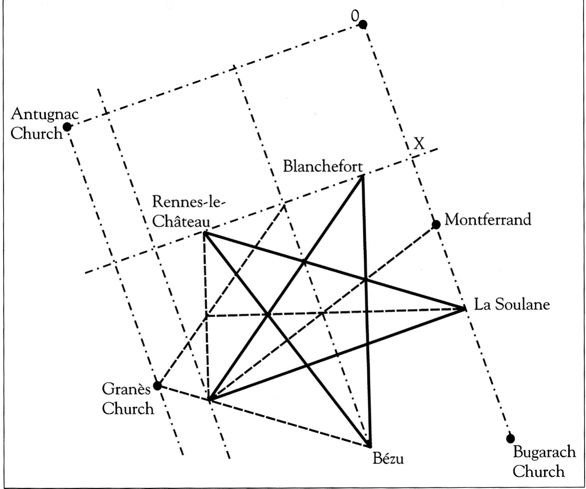
Image of French pentagram- permission from Henry Lincoln’s book, Key to the Sacred Pattern.
Another friend, Chris Street has found perfect star patterns formed by old churches, ancient wells and temple foundations in London…and the list goes on, including the discovery of a pentagram on Mars!
There is a deeper meaning in all these discoveries as indicated in the famous Hermetic maxim, “As Above, So Below.” The earth is a mirror of heavenly beauty and the ancient people designed their temples, stone circles, places of worship to reflect this perfection. During this time of awakening it is high time to once again live our lives to honor the song of the earth and sky, in celebration of the Uni-Verse, one song.
Qoyanaskatsi is a Hopi word meaning a world out of balance, and according to traditional elders in the Hopi tribe, we are now in the middle of a cycle of chaos and change, the Great Purification. We can see so many unstable patterns occurring in the global environment, politics, family structures and religion. And in a world out of balance, we find a general lack of coherent, harmonious systems where the whole living organism of the Earth is honored. Our prayer is that current global climate changes will serve to awaken humanity.
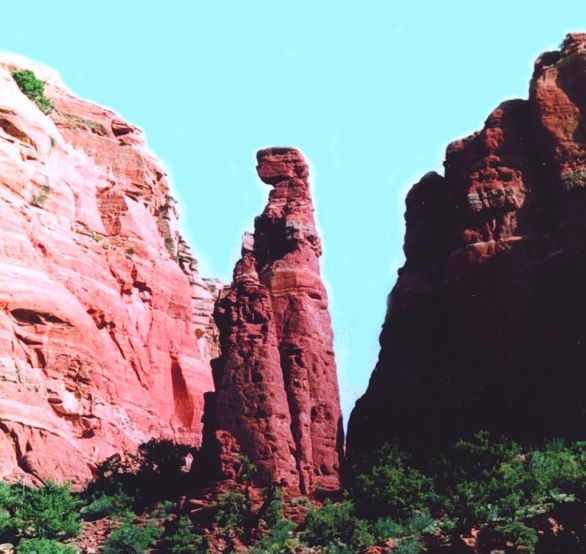
Old Stone Woman
If we look at some of the principles for living utilized by the Yavapai people who walked the Sedona-Verde Valley area before us, and search for integrity between the people and the natural landscape, we may find some clues to the inherent harmonious system that has always existed in this area. At one time, the Yavapai, or people of the sun, roamed an area of more than 20,000 miles, ranging from the Gila and Salt Rivers to the south, the Mogollon Rim to the north, and the Colorado River to the west. This area includes the Sedona red rock area, and it is said that even though the area from the San Francisco Peaks to the Verde River belonged to the Yavapai, no one lived in the Sedona area. This area was considered sacred and reserved for ceremonial purposes.
SEDONA SACRED EARTH
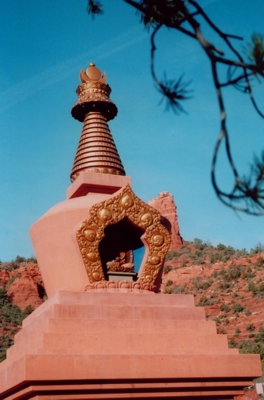 When Nicholas Mann first came from England to Sedona in 1987, he was both overwhelmed and enchanted by the expansiveness of the land and the rich diversity of flora and fauna and immediately began to research the history, legends and landscape of the area. His previous work in Great Britain included an education in ancient history, archeology and anthropology and his several published books were concerned with healing the earth-spirit relationship.
When Nicholas Mann first came from England to Sedona in 1987, he was both overwhelmed and enchanted by the expansiveness of the land and the rich diversity of flora and fauna and immediately began to research the history, legends and landscape of the area. His previous work in Great Britain included an education in ancient history, archeology and anthropology and his several published books were concerned with healing the earth-spirit relationship.
One night shortly after arriving in Sedona, Nicholas was awakened by a dream. In the dream, he heard: “…if the songs are not sung and myths are not told, then the land will die.” It reminded me of the Australian aboriginal worldview, in which all the life forms in nature are held in a state of harmony through the regular singing of ancestral songs. They say that the trees, animals and earth are singing a silent song and that we just need to sing back to them
“The Aborigines (Australian) say there is no difference between the songs
and the land they describe. The land spoke to the ancestors and gave its
inherent sound and shape so the native people could always be connected
to the earth and know where they are upon it.”
Nicholas Mann – Giants of Gaia
Nicholas began to search for the song and the story of Sedona. His research into university archives of the Southwest and uncovered the Sedona creation myths of the Yavapai people, and along with our extensive walking and listening in the hills and canyons and dowsing the Sedona earth energies, he soon completed the book Sedona Sacred Earth.
OLD STONE WOMAN
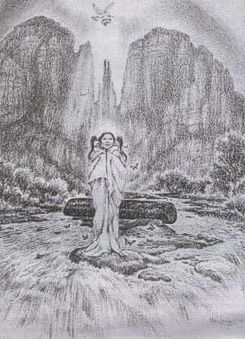 The following legends of the Yavapai come from the extensive stories compiled by E.W. Gifford in 1932-1936 as told by Mike Burns and Jim Stacey, both Yavapai and born in the 1800′s. Nicholas added a certain poetic flow to the lines, still keeping the original integrity of meaning.
The following legends of the Yavapai come from the extensive stories compiled by E.W. Gifford in 1932-1936 as told by Mike Burns and Jim Stacey, both Yavapai and born in the 1800′s. Nicholas added a certain poetic flow to the lines, still keeping the original integrity of meaning.
According to early records, first woman, Komwidpokuwia, old stone woman, originally came from Montezuma’s Well, where the Yavapai had been living. Before the great floods came, she was placed inside a hollow log, along with a bird and some food. Then they sealed the log with pitch so she would to float to a new place of safety to create the next world.
It is said that Komwidapokuwia landed in a high place in Boynton Canyon, where she lived in a cave. “She is the Goddess of the supernatural and medicine powers and is beautiful and as pure as a downy white feather… The medicine men, or anyone believing… may see her yet in a vision or dream and receive instructions, comfort and encouragement.” (Sedona Sacred Earth). The Yavapai-Apache still hold a beautiful ceremony every spring right below that emergence ‘Komwidapokuwia Emerging’ cave. It wasn’t until I actually participated in two of these Yavapai ceremonies in Boynton Canyon, that I truly felt welcomed into Sedona, after living here for two decades!
The following story of Yavapai first woman, Komwidapokuwia, tells us of her listening to the songs of heaven, and trusting and standing in that truth, to sing for all life. Perhaps we can integrate the Yavapai basic principles of deep listening and singing for all life, to heal our sacred landscape temple.
EXCERPTS FROM KOMWIDAPOKUWIA’S SONG
“Star powder heaven was used for her body
She came forth and stood and sang:
My talking and singing are life.
I speak for spiritual life
All over the world.
I speak and all the world
Lightens up to heaven.
This is the way I sing
When I listen to the songs of heaven.
Small heaven with white circles her chest was woven of,
She sang to make different all the world.
This she sang for the sake of the shamans.
She sang and flowers bloomed in the sky.
This is her way of singing:
My songs were made for the beautiful sky.
My word went out into the sky.
The world stood still.
A rainbow from heaven reached to this world.
Everything was still.
My song changed everything.
This is the way I sang when I was in the world.”
GOING AROUND IN THE RED ROCK COUNTRY
Knowing the creation myth for the area we live in is a large step toward connecting more profoundly with the spirit of place. Taking the time when we are in nature to deeply listen, to sing, to connect puts us in touch with the larger part of ourselves. And what are the presences that abide here. What are the patterns and relationships in the landscape that can help us deepen our experience of this sacred place?
GIANTS IN THE LANDSCAPE
In Nicholas’ book Giants of Gaia, co-written with Marcia Sutton, Ph.D., he brings to life the earth as a living being, with landscape forms taking on human and animal qualities. It is easy to see many of these giants in the Sedona landscape, such as Lizard Head, Giants Thumb, Isis Rock, Madonna Rock, and Camel Head, as well as many great birds, Egyptian sphinxes, faces and even geometric shapes.
“The Graeco-Latin word ‘gigans’ derives from the Sanskrit ‘go-jan’, meaning ‘earth’ and ‘giant’. Gigans meant a mighty being, one capable of giving birth. ‘Giant’ is a concept meaning a way of seeing that is large, inclusive and long lasting. Seeing the giants means seeing connections between the inner and the outer worlds. They are a way to connect with the greatest forces we can imagine.” Nicholas Mann - Giants of Gaia
One of the great mythic giants in the Sedona area is Skatakaamcha, the grandson of Komwidapokuwia. He is said to have gone over the ocean to visit his two fathers, Cloud and Sun by traveling on Spider’s Web.
SKATAKAAMCHA’S SONG
They gave me four lines of lightning
To descend to earth.
Two on the left belonged to Cloud
Two on the right belonged to Sun.
I descended on the lightning flashes.
I arrived at Komwidapokuwia’s place.
I knelt on the ground, and pressed.
With my hands and my knees I pressed
On the ground and sang.
When I lifted my hands
Medicine plants sprouted out of the earth …
… I will make new shamans
There are only new shamans now.
They will cure all disease by singing.”
Then he adds,
“… sing around my body
And you will get my songs.
If you sing my songs you will keep alive.”
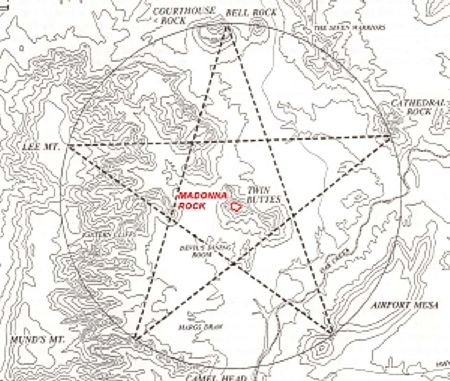
Madonna Rock Pentagram
Sedona Sacred Earth by Nicholas Mann
SNAKE SHRINES IN THE RED EARTH
“Our ancestors looked at the world as a complex whole. They saw every part of it moving with the breath of a unifying spirit. The same wind which moved the clouds and the trees moved in them. Their cosmos had loving mountains with blood vessels of lava, copper, iron and gold… and from this way of thinking, they saw giants.” (Giants of Gaia)
Many sacred sites around the world contain red earth, such as in Teotihuacan, Mexico, Dartmoor, England, Uluru in Australia, and sites in Tibet. The red ochre clay is used for healing and ceremony because of its life-giving properties. In Patagonia, Argentina, “Whenever an eclipse occurred, the women painted themselves with red earth and sang.” (Selk’nam Chants of Tierra del Fuego, or Earth of Fire).
At a 2001 workshop in Sedona on sacred geometry, well-known author Dan Winter, spoke about the high iron content of the red earth in Sedona being similar to human blood. “The red rocks have a high iron content, hence an ability to bend magnetic lines of force and a great ability to interact with the DNA in our blood.” He also spoke about the song in our blood (a poetic reference to his research on the frequencies within all biological systems), and said that the earth is sick because certain frequencies are missing. “The more natural frequencies you can get into the cells, the healthier the whole body.”
(See http://aniwilliams.com/voice_spectrum_analysis.htm )
Around the winter solstice of 1988, Nicholas Mann began searching the red rock hills for clues to the harmonious system in the landscape temple. In his book Sedona Sacred Earth, Mann describes the natural geometric figures he discovered through walking the land, dowsing, and using topographical maps and clues from the regional indigenous stories and legends. While speaking with the late Hopi Bear Clan chief, White Bear Fredericks, he learned that the Hopi had six shrines sacred to the Snake Clan in the Sedona area. White Bear described these as each having either ruins or petroglyphs marking the sites. Could the Hopi have placed these shrines in the Sedona red earth because of the strong magnetic power there which could increase the field of beneficial influence over the entire four corners region?
Before embarking on the Hopi Snake shrines, I should bring in a little background on snake symbology. The snake has unfortunately received bad press throughout history and often conjures fearful associations. However, in most indigenous and ancient cultures, the snake represents the powerful currents that move through the earth and the human body. In Egypt, the realized human was depicted with a cobra emerging out of the forehead, representing power, wisdom and the awakened Kundalini, or intertwined serpentine currents of the chakra system.
In the Hopi culture, the Snake Clan works closely with the Antelope Clan in maintaining the balance of earth and sky. During the summer, the two clans come together to dance to insure plentiful rain for the summer crops. The snake represents fertility and takes their messages into the earth, while the antelope is a sky messenger and represents the kopavi, or opening in the crown of the head, where one can communicate with the Creator.
“Running antelopes make the sound of thunder, whose vibration stimulates the clouds to come out of their shrines… The bull snake has the power to suck out life and rain from the clouds. So… the Snake Dance brings rain.”
Book of the Hopi–Frank Waters
I had the opportunity to experience the Hopi weather magic in the late eighties at the village of Shongopovi, the largest village on Second Mesa. It was a very dry summer and drought was threatening the Hopi crops of corn, peppers, squash and melons. I remember we hadn’t had rain for three months and the dancing began with a clear and cloudless sky. As the Antelope Clan danced with their antler head pieces, the Snake Clan danced with the live rattlesnakes on the opposite side of the plaza, both lines chanting and swaying. By the end of the dance, the Hopi Grandmothers, who had already witnessed the power of this dance many times, all pulled out their umbrellas as we observed black clouds forming suddenly overhead, along with several rainbows and loud thunder crashing. It began to rain hard and continued for three days, causing flooding throughout Northern Arizona.
So, as Nicholas Mann continued his quest to find the six snake shrines mentioned by White Bear in the red rocks, he trekked daily through the Dry Creek and Soldier Pass areas. “One day I walked up Soldier Pass, around the tall buttes to the north of Grayback and climbed up onto the rocks by Devil’s Bridge to obtain a good view of the landscape… the features that stood out most powerfully in the rock formations as I walked up Soldier Pass were the buttes below Wilson Mountain to the east, and Lost Wilson Mountain. Around the corner into the Dry Creek area, are the Grassy Knolls, Doe Mountain and the high peaks beside Secret, Long and Boynton Canyons.”
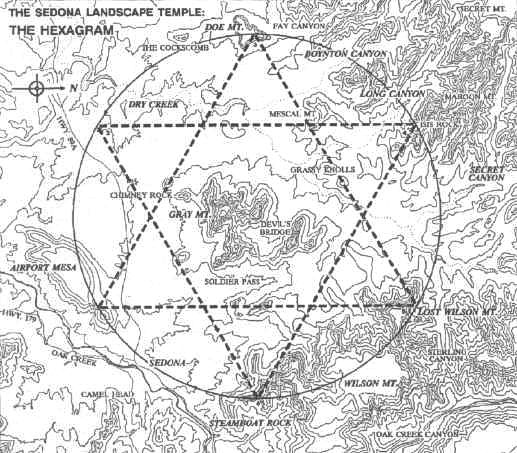 When he placed a compass on the map point above Devil’s Bridge, he discovered that many of the prominent formations that he had noted corresponded to points on a six-pointed star pattern, with Grayback or Thunder Mountain at the center. White Bear said that the six shrines were placed in an equidistant circle around the central emergence mound and kiva of the Snake Clan.
When he placed a compass on the map point above Devil’s Bridge, he discovered that many of the prominent formations that he had noted corresponded to points on a six-pointed star pattern, with Grayback or Thunder Mountain at the center. White Bear said that the six shrines were placed in an equidistant circle around the central emergence mound and kiva of the Snake Clan.
We really don’t know for sure whether the Hopi or their ancestors established snake clan shrines in these exact places in Sedona, but the symmetry of the prominent rock formations do fall on the points of a six pointed star, and there are ruins near each of the points, as well as at the center. Recently, I spoke with Sandra Cosentino of Crossing Worlds Journeys and she reported that one of the Hopi snake dancer priests has spoken about Hopi shrines in the Sedona area that they still actively work with ceremonially. I have personally seen snake petroglyphs at several sites in the Sedona region, including the ruins behind Isis Rock, one of the six points of the hexagram.
We have much to learn from the ancient ones who lived in this sacred red earth before us. When we walk through this beautiful land, if we listen to the songs in the stones we can sing their songs to increase the life energy and reconnect with a deeper part of ourselves and the giants of Gaia.
“We shall not cease from exploration and the end of all our exploring will be to arrive where we started… And know the place for the first time.”
T.S. Eliot – The Four Quartets
My friend and scientist Dan Winter once commented on a visit to Sedona that the magnetic properties of the iron-rich red earth resonate with the iron in our blood. This creates a magnetic connection between the earth and ourselves, stimulating what is stored in the DNA, in the blood and serves our awakening. Sometimes this strong magnetic effect can be quite strong and when people first visit red rock country, various reports of disorientation, insomnia, high energy and profound spiritual insight are experienced.
Photography and Article by Ani Williams ©2013
